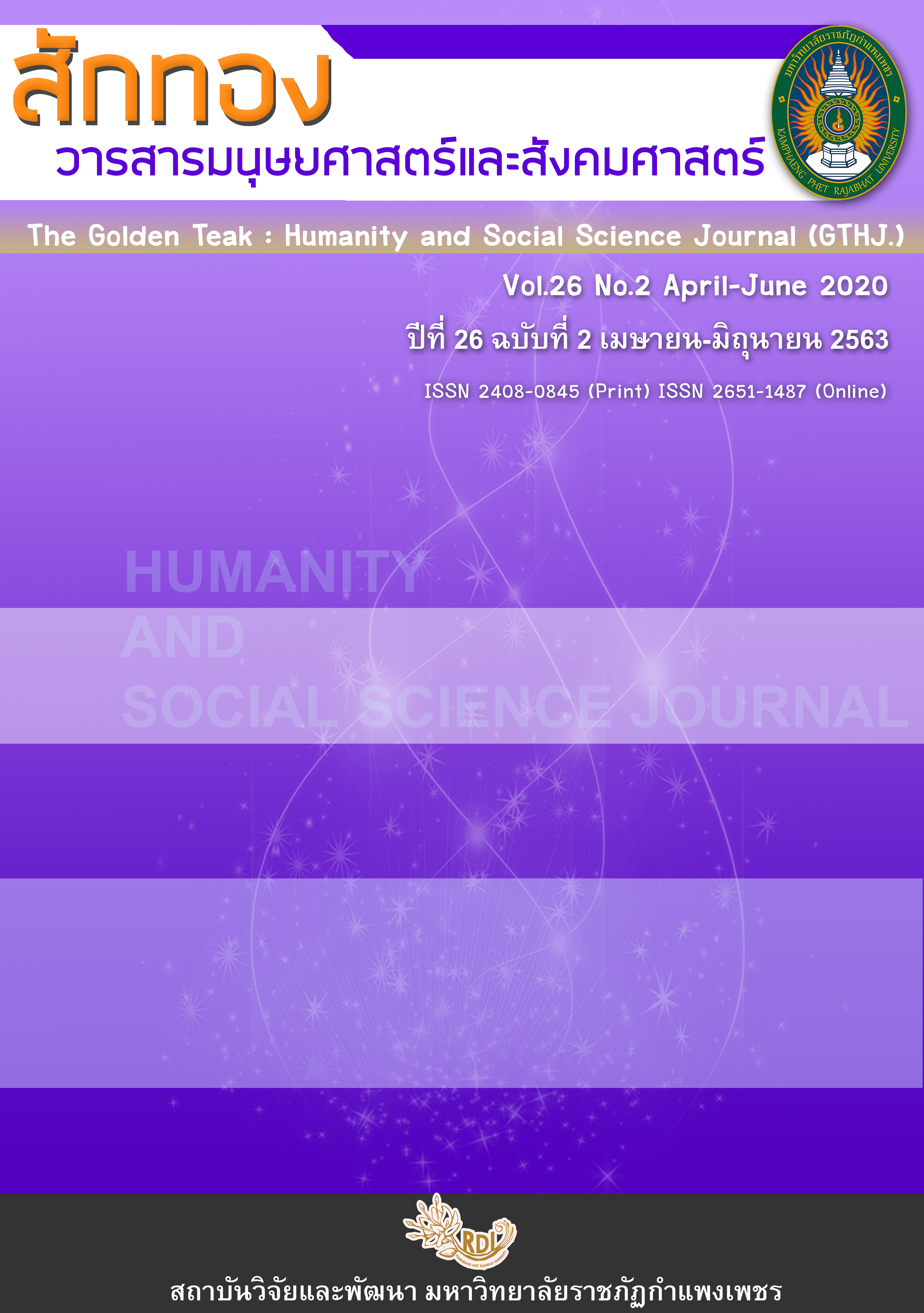Enhancing Musical Intelligence among Primary School Students with Whistling Song Activity Packages : Behavioral and EEG Study
Main Article Content
Abstract
The aims of this research were to design a set of whistle-blowing activities to enhance the musical intelligence of primary school students, and then to study the results of using them as an activity package to enhance musical intelligence. The subjects were 120 students in Grade 5. They were randomly assigned to the experimental group (Practice whistling as music) and the comparison group (Practice the flute), 60 students per group. Research instruments included the whistle-blowing activity package, musical intelligence test, and an EEG machine. Data were analyzed by using one-way ANOVA. The results were as follows: 1) The whistle-blowing activity package consisted of two sets of activities, 20 practice sessions, 45 minutes a day for 20 days. 2) After the experiment, the group that practiced whistling as music and the group practicing flute had an increase in intelligence scores of music at the statistical significance level of .05; no gender differences were detected when male and female results were compared. 3) Concerning the electroencephalogram study, differences were found after training at theta frequency at the right frontal F4 electrode site, at alpha frequency at the left frontal F3 electrode site, and also at the right antero-fronto-central FC6, F8 and AF4 electrode sites in the group that practiced whistling as music, while the flute group did not show differences in brainwaves, when compared to before-training conditions. 4) After training, differences in theta frequency were found between groups at the right frontal F4 electrode site and at the alpha frequency at the left frontal F7 electrode site and at the right frontal F4 electrode site.
Article Details
บทความที่ได้รับการตีพิมพ์เป็นลิขสิทธิ์ของวารสาร สักทอง : วารสารมนุษยศาสตร์และสังคมศาสตร์ สถาบันวิจัยและพัฒนา มหาวิทยาลับราชภัฏกำแพงเพชร
ข้อคิดเห็นใดๆ ที่ปรากฎในวารสารเป็นวรรณกรรมของผู้เขียนโดยเฉพาะ ซึ่งมหาวิทยาลัยราชภัฏกำแพงเพชรและบรรณาธิการไม่จำเป็นต้องเห็นด้วย
References
Banerjee, A., et al. (2016). Study on brain dynamics by nonlinear analysis of Music induced EEG
signals. Physical A : Statistical Mechanics and its Applications, 444(3), 110-120.
Barbey, A.K., Colom, R. & Grafman, J. (2013). Dorsolateral prefrontal contributions to human
intelligence. Neuropsychologia, 51(7), 1361-1369.
Butkovic, A., Ullén, F. & Mosing, M.A. (2015). Personality related traits as predictors of music
Practice : Underlying environmental and genetic influences. Personality and
Individual Differences, 74(3), 133-13
Corrigall, K.A. & Schellenberg, E.G. (2015). Predicting who takes music lessons : Parent and child
characteristics. Frontiers in Psychology, 6(2), 282-285.
Corrigall, K.A., Schellenberg, E.G. & Misura, N.M. (2013). Music training, cognition, and
personality. Frontiers in Psychology, 4(7), 222-223.
Degé, F., Kubicek, C. & Schwarzer, G. (2011). Music lessons and intelligence : A relation
mediated by executive functions. Music Perception : An Interdisciplinary Journal,
29(2), 195-201.
Degé, F., Wehrum, S., Stark, R. & Schwarzer, G. (2014). Music lessons and academic
self-concept in 12-to 14-year-old children. Musicae Scientiae, 18(2), 203-215.
dos Santos-Luiz, C., et al. (2016). Exploring the long-term associations between adolescents’
music training and academic achievement. Musicae Scientiae, 20(4), 512-527.
Dresel, C., et al. (2005). The functional neuroanatomy of coordinatedorofacial movements :
Sparse sampling fMRI of whistling. Neuroimage, 28(3), 588-597.
Edmonds, W. A. & Kennedy, T.D. (2017). An applied guide to research designs :
Quantitative, qualitative, and mixed methods. Florida, American Puplic : Nova
Southeastern University.
Gardner, H. (2011). Frames of mind :The theory of multiple intelligences. New York :
Basic books.
Gibson, C., Folley, B.S. & Park, S. (2009). Enhanced divergent thinking and creativity in
musicians : A behavioral and near-infrared spectroscopy study. Brain and Cognition,
69(1), 162-169.
Herholz, S.C. & Zatorre, R.J. (2012). Musical training as a framework for brain plasticity :
Behavior, function, and structure. Neuron, 76(3), 486-502.
Lawley, A., Khan, H.A. & Hegde, V. (2016). Multiple whistling seizures in temporal lobe epilepsy:
A case report and review of the literature. Clinical neurology and neurosurgery,
151(3), 61-64.
Moreno, S., et al. (2011). Short-term music training enhances verbal intelligence and
executive function. Psychological science, 22(11), 1425-1433.
Mosing, M.A., et al. (2016). Investigating cognitive transfer within the framework of music
practice : Genetic pleiotropy rather than causality. Developmental science, 19(3),
504-512.
Patston, T. & Osborne, M.S. (2016). The developmental features of music performance anxiety
and perfectionism in school age music students. Performance Enhancement &
Health, 4(1-2), 42-49.
Ribeiro, F.S. & Santos, F.H. (2017). Enhancement of numeric cognition in children with low
achievement in mathematic after a non-instrumental musical training. Research in
developmental disabilities, 3(62), 26-39.
Schellenberg, E.G. & Mankarious, M. (2012). Music training and emotion comprehension in
childhood. Emotion, 12(5), 887-690.
Sukwattana, K. (2011). Music appreciation in WesternMusic. (3 rd ed.) Bangkok :
Thai Watana Panich.
Trimmer, C.G. & Cuddy, L.L. (2008). Emotional intelligence, not music training, predicts
recognition of emotional speech prosody. Emotion, 8(6), 838-840.
Woodward, A. (1925). Whistling as an art. [Online]. Available :
https://archive.org/details/Whistling As An Art [2018, February 24].


